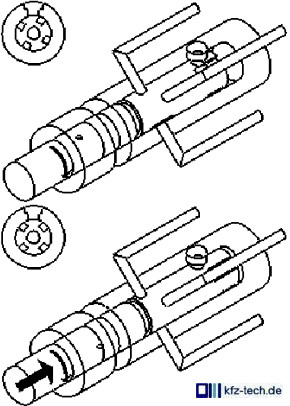Axial piston pump (high-pressure)

Assignment
The axial piston pump should inject a variable amount of water- and air free fuel at the specified time, under high pressure
through the injectors, into the combustion chamber.

Function
The central pump element is responsible for the high-pressure developement. It consists of a longish piston which is moved by the cam of a pressure plate which runs on a rolling ring (see top figure) after TDC and a
counterspring after BDC.
It is fitted into its cylinder with a tolerance of a 1/1000th of a millimetre. At the other end, there are the same amount of longitudinal slots machined into the piston, as the number of cylinders that the engine has.
In UT position the piston allows, through one of the longitudinal slots, a fuel inlet passage through which fuel can reach the plunger chamber. The piston is turned and thus, seals the connection between longitudinal
slot and the fuel inlet passage (2nd figure from the top).
During the further rotation the cam brings the piston to TDC and the fuel is highly compressed (3rd figure from the top). The fuel is assigned to a certain fuel-line in the high-pressure cylinder by a longitudinal- and a
radial distributor-drilling in the piston. At the end of this fuel-line, a pressure release valve opens. The
fuel flows in the form of a pressure wave to the injector, whose spring determines the injection pressure.
The high-pressure delivery ends if the fuel is relieved through a connection of the longitudinal drilling with the pump interior. This connection is sealed by a ring (control slide-valve), until the piston reaches a certain
point in the stroke. The control slide-valve serves the volume regulation. With the installation of this
distributor pump, its setting must be synchronised with that of the diesel engine. This is called the 'beginning of delivery' setting. To enable this, it is mounted onto a drilling which allows a limited rotation. A gauge which is screwed in, instead of the central screw-plug in the middle of the injection connections, is necessary. Its feeler must
remain in contact with the pump plunger during the entire measuring procedure.
A certain cylinder is turned backwards, away from the ignition TDC, until the gauge-needle can go no further. After one has saved this zero position, with the help of the adjustable tolerance marking, the engine is once
again turned forwards.
During the TDC operation, the gauge must indicate a certain value stipulated by the vehicle manufacturer (e.g., 9/100ths). If this is not the case, the measurement must be repeated after rotating the pump. With this
measurement however, only the static setting is assured. How the beginning of delivery shifts, at higher RPMs, cannot be influenced by this setting.
Important
Due to this low tolerance, the fuel must be well filtered before reaching the pump. 09/10
|